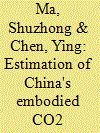| Srl | Item |
| 1 |
ID:
111441


|
|
|
|
|
| Publication |
2012.
|
| Summary/Abstract |
Trades create a mechanism of embodied CO2 emissions transfer among regions, causing distortion on the total emissions. As the world's second largest economy, China has a large scale of trade, which results in the serious problem of embodied CO2 emissions transfer. This paper analyzes the characteristics of China's CO2 emissions embodied in international and interprovincial trade from the provincial perspective. The multi-regional Input-Output Model is used to clarify provincial CO2 emissions from geographical and sectoral dimensions, including 30 provinces and 28 sectors. Two calculating principles (production accounting principle and consumption accounting principle, Munksgaard and Pedersen, 2001) are applied. The results show that for international trade, the eastern area accounts for a large proportion in China's embodied CO2 emissions. The sectors as net exporters and importers of embodied CO2 emissions belong to labor-intensive and energy-intensive industries, respectively. For interprovincial trade, the net transfer of embodied CO2 emissions is from the eastern area to the central area, and energy-intensive industries are the main contributors. With the largest amount of direct CO2 emissions, the eastern area plays an important role in CO2 emissions reduction. The central and western areas need supportive policies to avoid the transfer of industries with high emissions.
|
|
|
|
|
|
|
|
|
|
|
|
|
|
|
|
| 2 |
ID:
176898


|
|
|
|
|
| Summary/Abstract |
CO2 emissions embodied in international trade have drawn wide attention in the academia and national climate negotiations. In this study, we estimate the embodied CO2 emissions in the trade between China and Australia using long time series disaggregated sectoral data based on missions embodied in bilateral trade (EEBT) method, and analyse the major driving forces for these emissions changes based on structural decomposition analysis (SDA) method. The results show that export volume contributed to these embodied CO2 emissions increase, while emission intensity could offset these CO2 emissions increase. We further predict embodied CO2 emission in Sino-Australia trade under different scenarios and the results indicate that technology spillover can significantly reduce embodied CO2 emissions in trade. Electricity, transportation and cement industries have significant potential to reduce carbon emissions. In addition, we evaluate future carbon reduction potential till 2030. The results in this study can inform decision-makers for Australia and China to formulate energy conservation and emission reduction policies.
|
|
|
|
|
|
|
|
|
|
|
|
|
|
|
|
| 3 |
ID:
108395


|
|
|
|
|
| Publication |
2011.
|
| Summary/Abstract |
The problem of CO2 embodied in international trade has attracted increasing attention in China. To analyze this issue, the present paper directly calculates emission factors for 15 industries in 2002, 2005 and 2007. We then examine a consumption-based system and a single-region input-output model to estimate China's embodied emissions during 2000-2009. Our results show that, when a consumption-based system is adopted, China's emissions are lower than those reported by some international organizations. The rapid growth in China's exports is a key determinant of China's rising total emissions. All countries should strengthen their cooperation in improving their current greenhouse gas inventories. Furthermore, China needs to encourage trade in low-carbon products and technology.
|
|
|
|
|
|
|
|
|
|
|
|
|
|
|
|